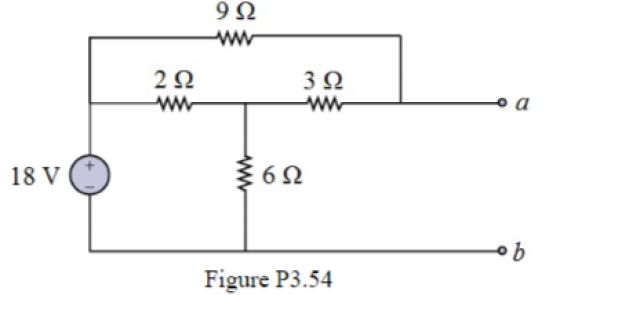FInd the the Norton equivalent?
2018-02-03 9:43 pm

回答 (1)
2018-02-04 6:24 pm
✔ 最佳答案
To find the Norton current (In), assume pionts a and b are connected together. Hence, current through the 9-ohm resistor = 18/9 A = 2 A
Becasue the 2-ohm resistor is in series with the 3-ohm and 6-ohm resistors in parallel (after a and b are connected), the equivalent resistance (Req) of this branch is,
Req = (2 + 3//6) ohms (here the symbol 3//6 means "3-ohm resistor connected in parallel with 6-ohm resistor).
Thus, Req = [2 + 3x6/(3+6)] ohms = (2 + 2) ohms = 4 ohms
Hence, voltage across resistance 3//6 (which equals to 2 ohms) = 18 x [2/(2+2)] v = 9 v
or voltage across 3-ohm resistor = 9 v (because 3-ohm and 6-ohm are in parallel)
Current through 3-ohm resistor = 9/3 A = 3 A
Since the current flows through a and b is the sum of currents from the 9-ohm resistor and 3-ohm resistor, we have,
the Norton current In = (2 + 3) A = 5 A
------------------------
To find the Norton resistance (Rn), assume the 18v source is in short-circuit. Here, we have two main branches of resistance. The 1st branch is simply the 9-ohm resistor. The 2nd branch is the 3-ohm resistor in series with the 2-ohm and 6-ohm resistors in parale.
First, calculate the resistance of the 2nd branch R2.
R2 = (3 + 2//6) ohms = (3 + 2x6/(2+6)) ohms = (3 + 1.5) ohms = 4.5 ohms
Therefore, the Norton equivalent resistance Rn = (9//4.5) ohms = 9x4.5/(9 + 4.5) ohms
= 3 ohms
收錄日期: 2021-04-11 21:44:57
原文連結 [永久失效]:
https://hk.answers.yahoo.com/question/index?qid=20180203134307AAUcy7M
